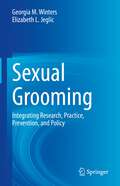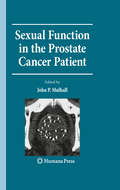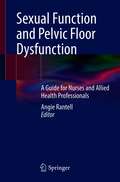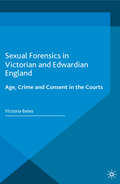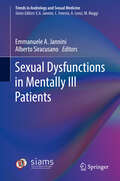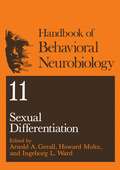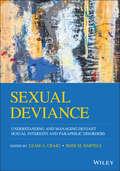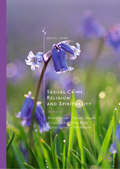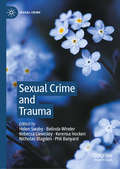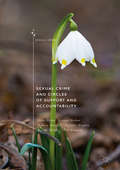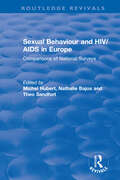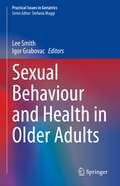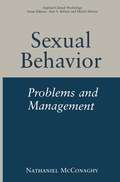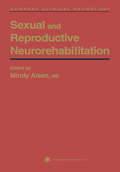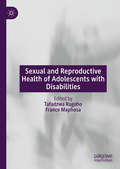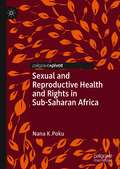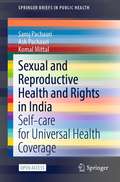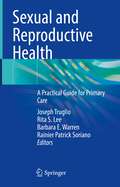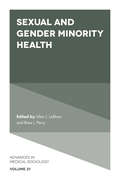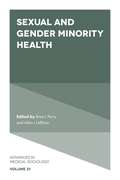- Table View
- List View
Sexual Grooming: Integrating Research, Practice, Prevention, and Policy
by Georgia M. Winters Elizabeth L. JeglicThis book provides an in-depth overview of the current research on sexual grooming. It explores the process by which an individual seeking to commit a sexual offense skillfully manipulates a potential victim into situations in which abuse can be more readily committed, while simultaneously preventing disclosure and detection. This volume addresses this understudied phenomenon and comprehensively examines what is currently known about the construct. It provides a thorough introduction to the sexual grooming literature, focusing on the history of the term and how sexual grooming strategies have become more publicly recognized through high-profile cases, as well as those in child-serving organizations (e.g., Catholic Church, Boy Scouts of America). The book reviews the various proposed models of sexual grooming – including the Sexual Grooming Model (SGM) – that detail the overarching steps or stages involved in the process. It discusses attempts to define the construct of sexual grooming and addresses potential consequences of sexual grooming, emphasizing how victims, families, and communities at large may be affected.Key areas of coverage include: Unique contexts and facets in which sexual grooming behavior has been observed, including online grooming, personal/self-grooming, familial grooming, institutional grooming, and grooming behaviors of females. The ways in which sexual grooming strategies may be manifested in sex trafficking cases and in adult sexual abuse. Assessment and treatment of sexual grooming, as well as prevention strategies. The implementation of grooming research to inform law enforcement efforts and court decision-making. The creation and adoption of legislation and policies designed to prevent sexual grooming. Child Sexual Grooming is an essential resource for researchers, professors, graduate students, clinicians, mental health therapists, legal professionals, policy makers, law enforcement, and related professionals in developmental psychology, child and adolescent psychology, social work, public health, criminology/criminal justice, forensic psychology, and behavioral therapy and rehabilitation.
Sexual Function in the Prostate Cancer Patient (Current Clinical Urology)
by John P. MulhallSexual dysfunction presents a major challenge to physicians who take on the task of treating men with prostate cancer. While curing the disease and saving a life is paramount, improving technologies and therapies offer skilled surgeons and clinical oncologists the opportunity to eradicate the disease without compromising sexual function. In Sexual Function of the Prostate Cancer Patient, John Mulhall and a panel of internationally recognized experts on prostate cancer and sexual function assess in detail the current state of prostate cancer treatment. The authors offer a broad overview of the pathophysiology and treatment of erectile dysfunction in men with prostate cancer, reviewing the latest findings regarding erection-sparing radiation therapy and sexual function outcomes after laparascopic and robotic prostatectomy. Additional chapters discuss intra-operative maneuvers to minimize post-operative erectile dysfunction and pharmacologic penile preservation and rehabilitation. Timely and authoritative, Sexual Function in the Prostate Cancer Patient is a highly readable guide to preserving post-prostate cancer sexual function that no urologist or radiation and medical oncologist should be without.
Sexual Function and Pelvic Floor Dysfunction: A Guide for Nurses and Allied Health Professionals
by Angie RantellThis book provides to nurses an understanding of female sexual function and dysfunction specifically in relation to common gynecological conditions. It offers evidence based overview of assessment of sexual function, including available questionnaires and provides a multidisciplinary approach to managing sexual dysfunction, from incontinence to pelvic organ prolapse and recurrent urinary tract infections. It also covers a holistic approach including over the counter and home treatments, psychological therapies, physical therapies, pharmacological options and if necessary more invasive interventions. Sexual function and pelvic floor dysfunction is often a neglected area due to the taboo nature of discussions. This book aims to educate nurses, to help them understand the types of treatment options available, and encourage them to engage in conversations about sexual function with women, so that they can be referred to appropriate health professionals and access the right care.
Sexual Forensics in Victorian and Edwardian England: Age, Crime and Consent in the Courts (Genders and Sexualities in History)
by Victoria BatesDrawing on court records from London and the South West, Sexual Forensics in Victorian and Edwardian England explores medical roles in trials for sexual offences. Its focus on sexual maturity, a more flexible concept than the legal age of consent, enables histories of sexual crime to be seen in a new light.
Sexual Dysfunctions in Mentally Ill Patients (Trends in Andrology and Sexual Medicine)
by Emmanuele A. Jannini Alberto SiracusanoThis book addresses the fundamental importance of the proper assessment and treatment of sexual disorders in patients with mental disorders with regard to their treatment outcomes and adherence to therapies. In fact, patients with mental disorders often suffer from sexual dysfunctions and in many cases, pharmacological treatment causes sexual-dysfunction side-effects. However, anxiety disorders, personality disorders, eating disorders and psychotic disorders are often also characterized by sexual symptoms that have a profound impact on sexual function. The psychopathology of sexual behavior investigates deficits in the mind-body relationship that are expressed through sexual symptoms such as erectile dysfunction, premature ejaculation, vaginismus, orgasmic disorders, or lack of sexual desire. These symptoms can be considered both prodromal and as a consequence of psychological or psychiatric suffering. Written by a multidisciplinary team of experts, this book offers a valuable guide for psychiatrists, andrologists, gynecologists and psychologists.
Sexual Dimorphism of the Bed Nucleus of the Stria Terminalis and the Amygdala (Advances in Anatomy, Embryology and Cell Biology #158)
by Nadya Stefanova Wladimir OvtscharoffSex differences are observed in various physiological, behavioral, and psychic functions, including reproductive behavior, aggres sion, emotions, and cognition. Such differences are expressed even in early childhood with preferences to definite activities. It has been generally accepted that differences between genders are formed under the influence of biological as well as environmental factors. The existence of sex differences in functions of the central nervous system has suggested that there are also morphological sex differences. In recent years several reports on sexual dimorphism in the brain of vertebrates have been published. However, the mecha nisms of sexual differentiation of the central nervous system remain unclear in most cases. It is often difficult to correlate morphological sex differences to differences in definite function or behavior. We set out to explore the sexual dimorphism of the limbic system and especially the bed nucleus of the stria terminalis and the amygdala, which are considered generally to be occupied with the control of reproductive behavior and autonomic and compli cated psychic functions. Several reports on sexual dimorphism of these structures have been published. Some of them have been directed to the total neuronal number and the volume of the nuclei, while others have concentrated on definite subpopula tions of neurons. In many cases the mechanisms of sexual differ entiation were tested, but sometimes they could not be estab lished.
Sexual Differentiation (Handbooks of Behavioral Neurobiology #11)
by Arnold A. Gerall Howard Moltz Ingeborg L. WardBased on a large variety of experiments on both humans and animals, this volume presents novel conceptualizations of the organizing consequences of hormones throughout the lifespans of mammals.
Sexual Deviance: Understanding, Assessing and Managing Deviant Sexual Interests and Paraphilic Disorders
by Leam A. Craig Ross M. BartelsThe essential text for understanding and managing deviant sexual interest and paraphilic disordersSexual Deviance is an authoratative text that provides an understanding to the assessment, management and treatment of sexual deviance and paraphilic disorders. The international panel of contributors- noted experts on the topic- illuminate the emerging theories that help to explain the developmental influences and pathways of sexual deviance and its connection to offending behaviour. The text considers various developmental influencee such as neurobiological pathways as well as the effects of pornography. The contributors highlight the assessment and diagnosis of sexual deviance and explore the links to offending behavior such as rape fantasy, algolagnic paraphilic, online viewing of indecent images of children, and sexual sadism. The book examines the effectiveness of a variety of current treatments including behavioral, pharmacological, cognitive behavioral therapy and systemic treatment. This important text: Offers contributions from an international panel of experts Examines the causes of deviant sexual interests Presents techniques for managing deviant sexual interests Includes information on co-morbid disorders and sexual offending Written for students and professionals in psychology, criminology, psychiatry, forensic nursing, and social work, Sexual Deviance explores deviant sexual interests in sexual offenders and reviews the techniques designed to manage behavior.
Sexual Deviance: Understanding and Managing Deviant Sexual Interests and Paraphilic Disorders
by Leam A. Craig Ross M. BartelsSEXUAL DEVIANCE The essential text for understanding and managing deviant sexual interest and paraphilic disorders Sexual Deviance is an authoritative text that provides an understanding to the assessment, management, and treatment of sexual deviance and paraphilic disorders. The international panel of contributors—noted experts on the topic—illuminate the emerging theories that help to explain the developmental influences and pathways of sexual deviance and its connection to offending behaviour. The text considers various developmental influences such as neurobiological pathways as well as the effects of pornography. The contributors highlight the assessment and diagnosis of sexual deviance and explore the links to offending behavior such as rape fantasy, algolagnic paraphilia, online viewing of indecent images of children, and sexual sadism. The book examines the effectiveness of a variety of current treatments including behavioral, pharmacological, cognitive behavioral therapy, and systemic treatment. This important text: Offers contributions from an international panel of expertsExamines the causes of deviant sexual interestsPresents techniques for managing deviant sexual interestsIncludes information on co-morbid disorders and sexual offending Written for students and professionals in psychology, criminology, psychiatry, forensic nursing, and social work, Sexual Deviance explores deviant sexual interests in sexual offenders and reviews the techniques designed to manage behavior.
Sexual Crime, Religion and Spirituality (Sexual Crime)
by Belinda Winder Nicholas Blagden Kerensa Hocken Helen Elliott Rebecca Lievesley Phil BanyardThis book offers a collection of original contributions to the literature on sexual crime, religion and spirituality. Does religion help people desist from sexual crime? Can it form the basis of interventions to rehabilitate people? Or does it provide justification and opportunity for committing it? What do the perpetrators say about their faith? What about the victims and survivors of sexual crime? The book asks and answers these questions and more in a unique collection of chapters – from academics, chaplains and prisoners. The book begins with an exploration of the role, history and development of chaplaincy in the prison system over the years, before providing a more personal look through the eyes of the Lead Chaplain at Rampton High Secure hospital in the UK. Subsequent chapters weave together theories of desistance from sexual crime, and analyses of perpetrators’ accounts of their offending are also offered, alongside firsthand accounts of prisoners from a range of religions. The book concludes with a thoughtful journey through the book by the Lead Chaplain at HMP Stafford, UK. It will provide fresh insights for students and scholars of psychology, criminology, theology and social work, as well as for practitioners, chaplains, and readers with an interest in learning about sexual crime, religion and spirituality.
Sexual Crime and Trauma (Sexual Crime)
by Helen Swaby Belinda Winder Rebecca Lievesley Kerensa Hocken Nicholas Blagden Phil BanyardThis book explores the growing understanding and evidence base for the role of trauma in sexual offending. It represents a paradigm shift, in which trauma is becoming an important risk factor to be considered in the treatment of individuals convicted of sexual crime. The authors consider the theoretical and historical explanations and understandings of sexual offending and its relationship with early trauma, paving the way for a volume which considers client’s treatment needs through a new, trauma-informed lens. The experiences and challenges of specific groups are also explored, including young people and women. Readable, yet firmly anchored in a sound evidence base, this book is relevant to psychologists, therapists, criminologists, psychiatrists, mental health nurses, social workers, students, and to practitioners and the general public with an interest in learning more about the topic.
Sexual Crime and Circles of Support and Accountability (Sexual Crime)
by Helen Elliott Kerensa Hocken Rebecca Lievesley Nicholas Blagden Belinda Winder Phil BanyardThis book offers a collection of original contributions to current research available on Circles of Support and Accountability (CoSA) by engaging with current literature and unpublished research in the field. The book explores the role of narrative identity in desistance from sexual crime and how CoSA maps onto this, as well as a history of CoSA across the world. The text then moves into an empirical section, reporting on some unpublished findings, including an evaluation of a new prison-based CoSA in the UK. Lastly, the experiences of service users and the influence of media perceptions are explored, offering a space for the ‘unheard voices’ as well as consideration of future directions for practitioners. The book is relevant not just to psychologists, criminologists, social workers and students, but to practitioners and the general public with an interest in learning about CoSA. The editors of this volume have all been involved in the setting up of the Safer Living Foundation, a charity formed in 2014 to reduce and prevent sexual offending.
Sexual Crime and Circles of Support and Accountability (Sexual Crime)
by Helen Elliott Kerensa Hocken Rebecca Lievesley Nicholas Blagden Belinda Winder Phil BanyardThis book offers a collection of original contributions to current research available on Circles of Support and Accountability (CoSA) by engaging with current literature and unpublished research in the field. The book explores the role of narrative identity in desistance from sexual crime and how CoSA maps onto this, as well as a history of CoSA across the world. The text then moves into an empirical section, reporting on some unpublished findings, including an evaluation of a new prison-based CoSA in the UK. Lastly, the experiences of service users and the influence of media perceptions are explored, offering a space for the ‘unheard voices’ as well as consideration of future directions for practitioners. The book is relevant not just to psychologists, criminologists, social workers and students, but to practitioners and the general public with an interest in learning about CoSA. The editors of this volume have all been involved in the setting up of the Safer Living Foundation, a charity formed in 2014 to reduce and prevent sexual offending.
Sexual Behaviour and HIV/AIDS in Europe: Comparisons of National Surveys (Routledge Revivals)
by Michel Hubert Nathalie Bajos Theo SandfortOriginally published in 1998 Sexual Behaviour and HIV/AIDS in Europe is detailed study comparing the major population surveys on sexual behaviour and HIV/AIDS carried out in Europe at the time of publication. Leading European researchers explore the differences and similarities between European countries in patterns of sexual behaviour and responses to the HIV/AIDS epidemic. As well as providing an empirical and methodological base for future research, the comparative analyses lead researchers, policy makers, health-educators and the media to new insights and a deeper understanding of issues that are of central concern in many countries. The chapters include discussion of data on sexual initiation, homosexual and bisexual behaviour, sexual practices, sexual partners, risk behaviour, STDs, preventive practices, the normative context, knowledge of HIV/AIDS, and attitudes towards people with HIV/AIDS. The book results from a major European Concerted Action, funded by the European Union Biomedical and Health Research programme (BIOMED), and coordinated by the Centre d'Etudes Sociologiques of the Facultes Universitaires Saint-Louis, Brussels, Belgium. It follows Sexual Interactions and HIV Risk, published in 1997.
Sexual Behaviour and HIV/AIDS in Europe: Comparisons of National Surveys (Routledge Revivals)
by Michel Hubert; Nathalie Bajos; Theo SandfortOriginally published in 1998 Sexual Behaviour and HIV/AIDS in Europe is detailed study comparing the major population surveys on sexual behaviour and HIV/AIDS carried out in Europe at the time of publication. Leading European researchers explore the differences and similarities between European countries in patterns of sexual behaviour and responses to the HIV/AIDS epidemic. As well as providing an empirical and methodological base for future research, the comparative analyses lead researchers, policy makers, health-educators and the media to new insights and a deeper understanding of issues that are of central concern in many countries. The chapters include discussion of data on sexual initiation, homosexual and bisexual behaviour, sexual practices, sexual partners, risk behaviour, STDs, preventive practices, the normative context, knowledge of HIV/AIDS, and attitudes towards people with HIV/AIDS. The book results from a major European Concerted Action, funded by the European Union Biomedical and Health Research programme (BIOMED), and coordinated by the Centre d'Etudes Sociologiques of the Facultes Universitaires Saint-Louis, Brussels, Belgium. It follows Sexual Interactions and HIV Risk, published in 1997.
Sexual Behaviour and Health in Older Adults (Practical Issues in Geriatrics)
by Lee Smith Igor GrabovacThis book provides a comprehensive overview for those interested in research and promoting sexual health in older people, as well as a “go-to” guide on the topic of sexual behaviour in older adults. Sexual activity is an essential part of intimate relationships, though it tends to decline in frequency as people grow older. Nevertheless, for many older people, sex still remains an important part of their life. There’s a common misconception that as people age, they lose their interest in sex and capacity for sexual behaviour. This is not the case, as a number of national surveys show. The new research presented here indicates that the less sex older people have, the more likely they are to experience mental and physical health problems. Men and women who reported a decrease in the frequency of sexual activities were also more likely to report a deterioration in self-perceived health. Additionally, men with erectile dysfunction were also more likely to be diagnosed with cancer or coronary heart disease. This research has also determined that older adults who experience a decline in sexual activity report poorer well-being than those who maintain their levels of sexual desire, activity and function in later life, and that men who remain sexually active in later life continue to have better cognitive performance compared to those who don’t. Despite these health benefits, medical professionals do little to promote sexual activity in older adults, and the literature suggests that there is a lack of knowledge on how to approach the subject and how to promote such activities. This is the first comprehensive book specifically exploring all areas of sexual behaviour and health in older adults, and drawing on the latest research in this area. It offers a valuable resource for researchers and clinicians in various health fields (medicine, nursing, occupational therapy, psychology, public health, etc.), as well as students in undergraduate and graduate programs.
Sexual Behavior: Problems and Management (Nato Science Series B:)
by Nathaniel McConaghyMany issues remain unresolved in sexuality. In some cases this is because the infor mation is not available to resolve them. In others it is, but the available conclusions the information supports block its acceptance, because they conflict with the posi tions of dominant groups in the politics of sexuality. Possibly the most obvious example is the determination of many theorists to ignore the evidence that while men rarely report being sexually assaulted, when questioned in community surveys, they make up a third of the victims, and a quarter of the perpetrators of sexual assault are women. These findings are incompatible with the feminist theory that sexual assault is not a sexual act, but normal male behavior motivated politically, to maintain men's dominance of women. Most research supporting the theory investigated women only as victims and men only as aggressors. Some feminists have dismissed the need for any research to support their beliefs on the ground that such research is "busy work" establishing what women already know. One belief considered not to require re search is that heterosexual pornography made for a male audience increases the prevalence of rape by encouraging rape-supportive attitudes of male aggression and female submission. No criticism has been directed at the soft-core pornography of "Mills and Boon" stories written for women that promote similar attitudes.
Sexual and Reproductive Neurorehabilitation (Current Clinical Neurology)
by Mindy AisenThis well-written text thoroughly addresses two quality of life issues in patients with a variety of neurological disorders: sexual and reproductive function. The de vasta stating effects of a variety of neurological diseases are well known to both the lay and medical communitIes, and are treated in numerous texts. However, as we continue to experience therapeutic breakthroughs in the tields of neurology and rehabilitation medicine, physicians and patients must become more aware of the issues discussed in this text. It is particularly important, as emphasized throughout the chapters, that the physician or therapist initiate conversations with the patients concerning both the possibility of parenting a child, as well as the ability of the patient to enhance his/her sexual functioning. Commonly in the patient who is otherwise perfectly normal, there is a reluctance to discuss these topics and couples often feel embarrassed to initiate a conversation with their physi cians. This reluctance to initiate a discussion is even more apparent in patients with a variety of neurological disorders, in which there are overriding fears concerning both function and survival, as well as deep concerns about their own attractiveness, and their sexual and repro ductive ability.
Sexual and Reproductive Health of Adolescents with Disabilities
by Tafadzwa Rugoho France MaphosaThis book investigates various experiences of teaching sexual and reproductive health to adolescents with disabilities. Following the adoption of the UNCRPD, adolescents with disabilities still commonly suffer from widespread violation of their rights particularly concerning sexual and reproductive health – often being viewed as either asexual or hypersexual. Contemporary societies do not readily encourage the participation of these young people in conversations or decision making processes concerning their own sexual and reproductive health. This book delves into such complex issues, critically examining how global communities attempt to teach sexual and reproductive issues to adolescents with disabilities in the modern era.
Sexual and Reproductive Health and Rights in Sub-Saharan Africa (Global Research in Gender, Sexuality and Health)
by Nana K. PokuThis book provides a clear and detailed examination of why it is so difficult to secure comprehensive political engagement and actionable, effective policy on sexual and reproductive health rights in sub-Saharan Africa. In an engaging analysis, Nana Poku employs expert knowledge to examine the prospects for large-scale improvements. He explores not only the full range of normative sensitivities, but also conceptual misunderstandings, legal difficulties and complex challenges of securing and maintaining adequate funding while AIDS remains a pandemic in the region. Up-to-date, succinct yet highly detailed, lucid and compelling in its diagnoses of highly complex issues, this book is a valuable, accessible study of a topic that is regional in focus but with clear global implications.
Sexual and Reproductive Health and Rights in India: Self-care for Universal Health Coverage (SpringerBriefs in Public Health)
by Saroj Pachauri Ash Pachauri Komal MittalThis open access book addresses self-care on sexual and reproductive health and rights and HIV prevention and treatment in the most marginalized and vulnerable communities. Case studies and personal narratives are used to share their perspectives and experiences, sources of information for self-care products, motivations for self-care, and challenges and outcomes. Self-care provides the way to reach the last mile in achieving universal health coverage and the Sustainable Development Goals. Issues related to stigma, discrimination and violence among these communities are highlighted. Changes in policies and programs to improve their sexual and reproductive health, education and employment are discussed. The last chapter in the book examines how the agenda on self-care can be advanced in the years ahead. The audience for this publication includes health professionals, researchers, those managing health institutions and service providers.
Sexual and Reproductive Health: A Practical Guide for Primary Care
by Joseph Truglio Rita S. Lee Barbara E. Warren Rainier Patrick SorianoThis book is a point-of-care resource for effective sexual and reproductive healthcare for patients of all ages, sexual orientations, gender identities and medical backgrounds in the primary care setting. This useful guide is divided into three parts, and other than part three, which deals exclusively with transgender and gender diverse patients, all content will relate to patients of all gender identities. Part one presents sexual and reproductive health (SRH) using a lifespan approach, including chapters on pediatrics, adolescents and young adults, adults, and older adult patients. Part two presents an approach to common SRH issues that span multiple age groups, including contraception and family planning, sexually transmitted infections and cancer screenings as well as sexual and reproductive health in the setting of common medical conditions. Part three is dedicated to sexual and reproductive health for transgender and gender non-binary patients, including psychosocial, medical, surgical and legal aspects of health. This book provides primary care clinicians with a framework for providing effective sexual and reproductive healthcare to patients of all ages, sexual orientations and gender identities in a way that is inclusive, focuses on health, and addresses the needs unique to specific populations.
Sexual and Gender Minority Health (Advances in Medical Sociology #21)
by Allen J. Leblanc and Brea L. PerryResearch concerning sexual and gender minority (SGM) health has flourished in recent years in conjunction with a period of intense social, political, and legal discourse about SGM persons. While this attention has increased understanding and recognition of SGM experiences, recent advances have often been met with resistance and backlash rooted in social stigma and long histories of discrimination. This volume of Advances in Medical Sociology showcases rich theoretical and empirical contributions on SGM health and wellbeing. The chapters address a variety of topics, drawing from classic and contemporary sociological frameworks and constructs, and reflecting intersecting interdisciplinary approaches to SGM health. Research presented in this volume provides an in-depth focus on sexual and/or gender minority populations, as well as the diverse sub-populations within them; theoretical and empirical explanations for SGM health disparities and resilience; aging and life course perspectives on the health experiences of SGM persons; health in the context of critical relationships in the lives of SGM persons; and the experiences of seeking general and specialized health care among SGM. The time is ripe for deeper examinations of the social determinants of SGM health, and this volume seeks to begin filling existing gaps in the literature.
Sexual and Gender Minority Health (Advances in Medical Sociology #21)
by Brea L. Perry Allen J. LeBlancResearch concerning sexual and gender minority (SGM) health has flourished in recent years in conjunction with a period of intense social, political, and legal discourse about SGM persons. While this attention has increased understanding and recognition of SGM experiences, recent advances have often been met with resistance and backlash rooted in social stigma and long histories of discrimination. This volume of Advances in Medical Sociology showcases rich theoretical and empirical contributions on SGM health and wellbeing. The chapters address a variety of topics, drawing from classic and contemporary sociological frameworks and constructs, and reflecting intersecting interdisciplinary approaches to SGM health. Research presented in this volume provides an in-depth focus on sexual and/or gender minority populations, as well as the diverse sub-populations within them; theoretical and empirical explanations for SGM health disparities and resilience; aging and life course perspectives on the health experiences of SGM persons; health in the context of critical relationships in the lives of SGM persons; and the experiences of seeking general and specialized health care among SGM. The time is ripe for deeper examinations of the social determinants of SGM health, and this volume seeks to begin filling existing gaps in the literature.
